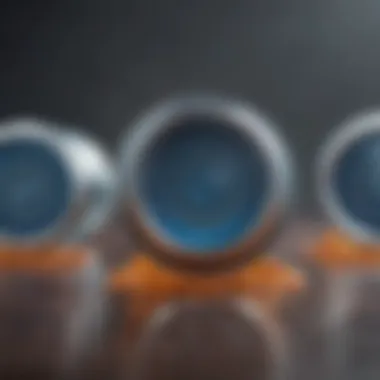Exploring the Hysitron Nanoindenter: Insights and Impact


Intro
The Hysitron nanoindenter has gained remarkable attention in the field of materials science due to its precision and versatility. This instrument enables researchers to understand the mechanical properties of materials at the nanoscale. It plays a critical role in many areas, including but not limited to, coatings, biomaterials, and nanocomposites. Those who engage with this technology find that it provides insights which are not easily attainable through traditional methods.
The operational principles of the Hysitron nanoindenter involve applying controlled forces to a sharp indenter that penetrates the surface of the material. Data collected can pinpoint characteristics like hardness and modulus. This process is vital, as the properties of materials at the nanoscale can differ significantly from their macroscopic analogues. Researchers can employ this data to make informed decisions in their work.
With this context, the exploration of how the Hysitron nanoindenter operates will yield a clearer understanding of its enhancements and diverse applications. It is imperative to highlight its importance in advancing the frontiers of material research and technology.
Foreword to Nanoindentation Technology
Nanoindentation technology serves as a pivotal tool in materials science, highlighting its significance in the analysis of mechanical properties at the nanoscale. This section aims to establish a framework for understanding the core principles and developments that characterize this innovative technique. With advancements in nanoindentation, researchers gain a valuable method for investigating material behavior under various conditions.
Unlike traditional indentation techniques, nanoindentation offers precision and control, enabling the measurement of hardness, modulus, and other properties at very small scales. This capability is crucial as materials continue to shrink in size and become more complex. Evaluating their mechanical attributes is vital for applications in nanotechnology and materials engineering.
Definition and Purpose
Nanoindentation is a technique used to measure the mechanical properties of materials at the nanometer scale. It involves the controlled penetration of a sharp indenter into the material's surface to gather data about the material's hardness and elastic modulus. The main purpose of this method is to provide accurate, reproducible values that facilitate the analysis of materials that are often too small for conventional hardness testing methods.
By utilizing nanoindentation, researchers can explore a wide range of materials, from metals and polymers to ceramics and thin films. This versatility makes it an essential methodology in various research disciplines, including solid mechanics and materials science. Scientists frequently rely on the data produced through nanoindentation for product development and quality control, ensuring that materials meet the required specifications for performance and safety.
Historical Context
The roots of nanoindentation trace back to the need for precise measurement techniques in materials science. Early hardness tests relied on larger scales, often with limited ability to discern subtle differences in material properties. As industrial applications grew more demanding, the limitations of conventional methods became evident.
In the 1990s, the introduction of the Hysitron nanoindenter marked a significant evolution in this field. This instrument enabled researchers to conduct hardness tests with great accuracy, measuring the mechanical properties of materials that were previously difficult to analyze. As technology advanced, the capabilities of nanoindenters improved, allowing for more complex analyses and the study of nanostructured materials.
The historical development of nanoindentation provides context for understanding its relevance in modern research. As nano science continues to expand, seeking to manipulate and understand materials at even smaller scales, the importance and applicability of nanoindentation will only grow. This section sets the stage for exploring the specifics of the Hysitron nanoindenter and its role in contemporary research.
Overview of Hysitron Nanoindenter
The Hysitron nanoindenter plays a crucial role in the realm of material science, providing sophisticated tools for the assessment of mechanical properties at the nanoscale. This section will detail the design, components, and operational mechanism that constitute the basis of this instrument. By comprehending these aspects, researchers can better leverage the capabilities of the Hysitron nanoindenter in their studies, from basic research to applied science.
Design and Components
The design of the Hysitron nanoindenter is meticulously engineered to facilitate high precision and accuracy during indentation tests. Essential components include the indenter itself, typically made from diamond, which allows for the extreme hardness necessary for testing a variety of materials. The load frame, which supports the indenter, is constructed to minimize flexure and to maintain stability throughout the testing process. Digital detectors and sensors are used to precisely measure the depth of indentation and the applied force throughout the examination.
Furthermore, the system often includes a vacuum chamber that ensures a controlled testing environment, reducing factors such as contamination and humidity that may skew results. The integration of advanced software with real-time data monitoring is vital, as it allows for immediate adjustments and precise data collection during experiments. Understanding these components helps researchers appreciate how each element contributes to the performance, reliability, and flexibility of the equipment in diverse testing scenarios.
Working Mechanism
The working mechanism of the Hysitron nanoindenter is based on the principle of nanoindentation, which captures the mechanical properties of materials through controlled indentation. Initially, the indenter makes contact with the material's surface. A loading program is initiated, whereby a specific force is applied to the indenter. The depth and load data are continuously recorded, forming a curve that represents the material's response to the applied force.
When the indenter penetrates the surface, several mechanical properties can be extracted, such as hardness, elastic modulus, and creep behavior. This data is vital for applications in fields such as nanotechnology, biomaterials, and coatings. The unloading phase is equally significant as it allows for the observation of permanent deformation, enabling researchers to assess not just the immediate response but also the long-term implications of material behavior under stress.
"Understanding the working mechanism of the Hysitron nanoindenter is essential for accurate data interpretation and can impact research findings significantly."
Operational Principles
Understanding the operational principles of the Hysitron nanoindenter is crucial for researchers and professionals working in material science. These principles dictate how the device performs tests, providing insights into a material's mechanical properties. The information acquired from these tests helps in designing better materials and predicting their behavior under various conditions.


Indentation Techniques
Indentation techniques employed by the Hysitron nanoindenter are diverse and tailored to measure material hardness and mechanical properties with precision. Two common techniques include:
- Continuous Stiffness Measurement (CSM): This technique allows for real-time monitoring of stiffness as the indenter penetrates the material. It provides a detailed view of how the material responds to applied pressure.
- Load-Depth Curves: This method generates a curve that maps the relationship between the load applied and the depth of indentation. Analyzing this curve permits the calculation of hardness and elastic modulus.
These techniques reveal how a material behaves under different conditions, aiding in various applications, such as coatings and nanostructures. By utilizing this advanced technology, researchers can obtain a fine resolution of data that is critical for understanding materials at the nanoscale.
Data Acquisition and Analysis
After the indentation process, data acquisition and analysis are paramount. The Hysitron nanoindenter is equipped with sophisticated software that captures and processes data generated from the indentation tests.
Some key aspects include:
- Data Logging: The system logs various parameters such as load, displacement, and time during the tests. This facilitates the creation of robust datasets for further analysis.
- Statistical Analysis: It often includes calculating mean values, standard deviations, and other statistical measures, which help in determining the reliability of results.
- Visualization Tools: Advanced visualization tools allow researchers to interpret data graphically. This helps in spotting trends and drawing meaningful conclusions.
An effective analysis method can significantly alter the understanding of a material's characteristics. By accurately interpreting results, researchers can innovate and develop new materials with enhanced properties or better durability.
"The ability to analyze nanomechanical properties with such precision allows material scientists to explore new avenues in material design and application."
In summary, the operational principles of the Hysitron nanoindenter facilitate in-depth material analysis, yielding data that is not only reliable but also critical for advancing material science.
Applications in Material Science
Material science is a broad and vital field that intersects with multiple industries such as aerospace, electronics, and biomaterials. The Hysitron nanoindenter plays a crucial role in this discipline by allowing scientists and engineers to conduct detailed examinations at the nanoscale. Applications have transformed our understanding of material properties, leading to advancements in technology and innovative solutions.
The advantages of using a Hysitron nanoindenter come from its capability to measure hardness and elastic modulus at very small scales. This precision has opened up opportunities to analyze new materials which were previously challenging to assess accurately. Furthermore, it offers insights that are essential in the development phases of various applications.
Metals and Alloys
The investigation of metals and alloys using the Hysitron nanoindenter is quintessential in optimizing their properties for specific industrial applications. Through controlled indentation tests, researchers can determine the hardness, strength, and fatigue resistance of materials. For example, titanium alloys are particularly relevant in aerospace applications due to their strength-to-weight ratios. By identifying the optimal alloy composition, manufacturers can ensure improved performance while minimizing weight.
The precise data obtained from nanoindentation allows for the fine-tuning of metals and alloys, leading to innovations that meet specific engineering requirements.
Ceramics and Composites
Ceramics and composites present unique challenges due to their brittle nature. The application of the Hysitron nanoindenter allows for the measurement of fracture toughness and elastic properties. This information is critical for developing materials that are used in high-stress environments, such as turbines and structural components.
In the case of advanced ceramics, such as zirconia or silicon nitride, nanoindentation helps identify the influence of microstructural features on mechanical performance. Researchers can evaluate how processing methods impact the material's resistance to wear and failure, further supporting innovations in manufacturing and design.
Thin Films and Coatings
Thin films and coatings are essential in industries ranging from electronics to automotive. The Hysitron nanoindenter provides the capability to investigate mechanical properties of these materials at nanometer scales. This aspect is particularly important as the performance of coatings can significantly affect the longevity and effectivity of devices.
For instance, in semiconductor applications, thin films must not only possess adequate thickness but also satisfactory hardness and adhesion properties. Assessing these attributes ensures that devices operate effectively and reliably over time. With nanoindentation, researchers can systematically explore how variations in deposition techniques or materials impact these properties.
With the important insights gained through the Hysitron nanoindenter, the material science community is better equipped to devise innovative materials and applications following industry needs.
Comparative Analysis with Other Testing Methods


The evaluation of material properties is crucial in scientific research. It is important to compare different testing methodologies to understand the strengths and weaknesses of each. The Hysitron nanoindenter, a leading tool in this field, offers unique advantages when placed alongside other methods. By examining both microhardness testing and spherical indentation, one can appreciate the specific capabilities of the nanoindenter and its application in advanced material characterization.
Microhardness Testing
Microhardness testing is a prevalent method utilized to determine the hardness of materials at micro and sub-micro scales. Techniques such as Vickers and Knoop hardness tests allow researchers to assess material hardness with precision. However, these methods typically involve a larger indentation depth, which can influence the results, especially in materials that have heterogeneous structures.
In contrast, the Hysitron nanoindenter employs a significantly lower force and smaller indenter tips. This capability allows for more localized and accurate hardness measurements. By applying a controlled load, the nanoindenter can evaluate materials with fine structures without affecting their integrity. The ability to measure hardness on a nanoscale provides insights that microhardness tests might miss.
Some benefits of using nanoindentation over traditional microhardness methods include:
- High Resolution: Nanoindentation provides detailed maps of hardness variations across a material.
- Less Damage: Due to its minimized force application, it reduces the potential to alter the microstructure of tested materials.
- Automated Data Collection: The integration with powerful software allows for rapid data analysis and enhanced reproducibility.
Spherical Indentation
Spherical indentation is another alternative testing method that has gained popularity in recent years. Unlike sharp indenters employed in nanoindentation, spherical indentation uses a rounded tip. This technique is particularly useful when assessing ductility and yielding in bulk materials. However, it also has its limitations. For example, spherical indentation can provide less localized information about material properties when working with small samples or thin films.
The Hysitron nanoindenter excels in this area by enabling a much finer analysis of material properties. The software integration allows for dynamic adjustments in the testing parameters, ultimately enhancing the accuracy of the results obtained with spherical indenters. Researchers can compare data across several indentation techniques, drawing conclusions regarding the mechanical behavior of various materials.
Advancements in Nanoindentation Technology
The field of nanoindentation technology is continually evolving. Advancements in this area deepen our understanding of material properties and enhance research capabilities. Notably, these innovations focus on improving the accuracy and sensitivity of measurements, as well as integrating automated systems with sophisticated software. The importance of these advancements cannot be overstated. Surpassing previous limitations, they provide researchers with increasingly reliable data and insights into materials at the nanoscale.
Improved Accuracy and Sensitivity
High accuracy and sensitivity are essential for meaningful nanoindentation results. Modern Hysitron nanoindenters excel in both areas, thanks to refined data acquisition techniques. Improved calibration techniques ensure that the force and displacement measurements are exceedingly precise. With advances in probe design, it becomes possible to analyze smaller and harder materials without compromising the measurement quality.
Furthermore, enhanced sensitivity allows researchers to detect minute changes in material properties that were previously undetectable. This leads to better interpretations of mechanical behaviors. For example, it helps understand the effects of grain boundaries or defects in metals and ceramics. A noteworthy outcome is the capacity to function effectively across a range of temperatures and environmental conditions.
Automated Systems and Software Integration
The integration of automated systems in nanoindentation provides significant benefits. Automation streamlines workflows, which can reduce human error and increase the reproducibility of experiments. Modern Hysitron systems incorporate features that enable multiple indentations to be carried out in quick succession. This efficiency is particularly valuable in large-scale studies where many samples must be analyzed.
Additionally, the software used in conjunction with these systems aids in data analysis and visualization. Advanced algorithms help in the interpretation of complex datasets, allowing for a clearer understanding of material behavior. Researchers can model results more accurately and predict how materials will perform under various conditions. This nexus of automation and software potential can transform research processes, suggesting new directions for material science investigations.
"Advances in nanoindentation technology ensure more precise measurements, leading to vital discoveries about materials at the nanoscale."
In summary, the advancements in nanoindentation technology mark a critical evolution in materials research. By enhancing accuracy and integrating automated systems with sophisticated software, researchers can unlock new potentials in materials analysis. The ongoing development in this field continues to shape the future of materials science.
Case Studies in Research
The exploration of case studies related to nanoindentation reveals critical insights into material characterization and innovation. Focusing on the Hysitron nanoindenter, these case studies illustrate its role in advancing material science by providing practical applications and validation of theoretical concepts. The detailed examination of specific instances enhances understanding of the nanoindenter's capabilities, fostering a bridge between theory and applied science. This relevance is significant for researchers, as these case studies highlight real-world benefits and considerations.
Nanomaterials Characterization
Nanomaterials characterization is a vital process that relies on the precision afforded by the Hysitron nanoindenter. This widely-used tool allows scientists to assess the mechanical properties of materials at the nanoscale. Through various techniques, such as load-displacement measurements, researchers can accurately determine hardness, elasticity, and other essential properties.
The significance of these characterizations cannot be understated. Particularly in fields like nanotechnology, where the performance of materials often hinges on their nanoscale integrity, the Hysitron nanoindenter provides clarity that is otherwise hard to achieve.
Some key applications of nanoindentation in nanomaterials characterization include:


- Investigation of nanocomposites: Understanding how different components interact at the nanoscale can lead to the development of superior materials.
- Assessment of thin films: In coatings, where mechanical properties directly affect performance, the nanoindenter allows precise evaluations.
- Study of particle agglomeration: The mechanical behavior of nanoparticles can influence their efficacy in various applications.
Researchers have often found that findings from nanoindentation correlate well with computational predictions, reaffirming the testing methodology's reliability. Characterization using the Hysitron nanoindenter creates a feedback loop, refining material design and research approaches.
Biomaterials Application
In the realm of biomaterials, the understanding of mechanical properties is critical, especially when these materials interact with biological systems. The Hysitron nanoindenter has found numerous applications in the characterization of biomaterials, offering detailed insights into their performance under physiological conditions.
Applications are particularly relevant in:
- Tissue engineering: To create scaffolds that mimic natural tissue properties, accurate mechanical characterization is essential.
- Dental materials: Understanding the wear resistance of dental composites helps in improving their lifespan and patient outcomes.
- Orthopedic implants: The material’s hardness and elasticity can influence integration with bone tissue, essential for implant success.
The assessment process typically involves indenting biomaterials and analyzing the resulting data for hardness, modulus, and other mechanical properties. This data is crucial in the development and optimization of biomaterials used in diverse medical applications. By translating these properties into real-world outcomes, the Hysitron nanoindenter significantly contributes to advancements in medical technology.
"The integration of advanced characterization techniques, such as those offered by the Hysitron nanoindenter, enhances the reliability of biomaterials used in surgical procedures and restorative applications."
Future Directions in Nanoindentation Research
The field of nanoindentation is continuously evolving, signaling significant changes in materials research and development. The future directions in this domain are vital because they highlight ongoing advancements and new potential applications. Researchers are now focusing on integrating novel materials in studies, employing more sophisticated technologies, and exploring interdisciplinary approaches that bridge various scientific domains. These efforts can lead to enhanced material characterization methods and inspire innovations across industries.
Emerging Materials and Applications
As materials science progresses, so does the need to study unconventional materials. Emerging materials, such as nanocomposites, 2D materials, and functionalized surfaces, present fascinating opportunities for exploration. Nanoindentation will play a crucial role in assessing the mechanical properties of these materials.
- Nanocomposites: These materials, composed of nanoparticles embedded in a matrix, require tailored mechanical assessments to understand their behavior in various applications such as aerospace and automotive industries. Their unique properties can help achieve lightweight yet strong designs.
- 2D Materials: The rise of graphene and other 2D materials has generated interest in their extraordinary mechanical properties. Researchers aim to use nanoindentation to quantify their hardness and elasticity, which are critical for potential applications in electronics and thermal management.
- Functionalized Surfaces: Innovations in surface engineering also demand precise characterization. Nanoindentation helps in evaluating the mechanical characteristics of coated or treated surfaces, ensuring they meet specific performance criteria in industries ranging from medical devices to energy systems.
"Investigating emerging materials not only enhances our understanding of their properties but also unlocks new pathways for technological innovation."
Interdisciplinary Research Opportunities
Interdisciplinary research is increasingly essential for advancing nanoindentation technologies. Collaboration between materials scientists, chemists, and engineers can lead to breakthroughs in both fundamental understanding and applied research.
- Materials Design: By integrating principles from chemistry and materials science, researchers can develop new materials that exhibit desirable mechanical properties. Nanoindentation can validate their effectiveness and play a role in understanding the relationship between structure and performance.
- Biomaterials Applications: In medical fields, understanding the mechanical properties of biomaterials is vital. Collaborations among biologists, materials engineers, and healthcare professionals can harness nanoindentation techniques to develop safer and more effective materials for use in implants and prosthetics.
- Nanoelectronics: As devices shrink in size, understanding the mechanical properties of nanoscale components becomes essential. Interdisciplinary teams that combine physics, engineering, and materials science can leverage nanoindentation for developing the next generation of electronic devices.
By pursuing these interdisciplinary investigations, the nanoindentation community can unravel the complexities of new material systems and foster innovation across multiple sectors.
Finale
In this article, we examined the Hysitron nanoindenter and its pivotal role in advancing materials science. The conclusion draws together several essential insights that underline its significance in the field.
Summarizing Key Insights
The Hysitron nanoindenter represents a cutting-edge tool that enables precise measurement of mechanical properties at the nanoscale. Key insights from the exploration include:
- Precision and Accuracy: The ability of the nanoindenter to provide high-accuracy measurements aids scientists in better characterizing materials. The analytical methodologies employed are robust, ensuring data reliability.
- Diverse Applications: This instrument does not limit itself to certain materials. Its applications extend across metals, ceramics, and biomaterials, showcasing versatility.
- Technological Advancements: Innovations in software and automated systems have enhanced the usability and efficiency of the device, allowing researchers to get more from their experiments.
Through these points, the article emphasizes how the Hysitron nanoindenter bridges the gap between theoretical research and practical applications, facilitating advancements across various domains of science.
Importance for Future Research
The relevance of the Hysitron nanoindenter for future research cannot be overstated.
- Emerging Material Insights: As new materials are developed, the need for effective characterization remains. The nanoindenter will play a crucial role in examining these materials at a level not previously possible.
- Interdisciplinary Collaboration: This instrument fosters collaboration between disciplines such as biology, chemistry, and engineering. Advanced materials analysis will drive innovations and discoveries in diverse fields.
- Progressive Methodologies: The ongoing improvements in nanoindentation techniques promise to enhance our understanding of material behaviors under various conditions, ensuring continuous growth in the field.
Overall, the enduring impact of the Hysitron nanoindenter is clear. Continued research and development will undoubtedly lead to significant breakthroughs in materials science and beyond.















